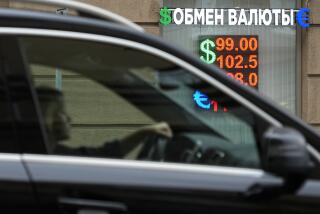Soviet Farmers to Get Dollars as an Incentive
- Share via
MOSCOW — The Soviet government, in a daring and unprecedented effort to boost agricultural output and get food into the stores, announced Thursday that it will start paying farmers partly in foreign currency, presumably dollars.
While providing financial incentive, the move also implicitly acknowledges the relative worthlessness of the ruble, which is not convertible on the world market and which generally buys too little in a nation crippled by persistent shortages.
Hard Currency
Starting this year, farmers will be paid in hard currency for anything they produce above-average annual levels in the period 1981-1985, the official Soviet news agency Tass said.
The program will not deal with a key problem in the Soviet food chain: As much as 25% of some crops spoil on the way to market. Nevertheless, it is a bold effort to encourage farmers to grow more, and it is likely to encounter criticism from conservatives.
In an apparent effort to counter expected criticism, the Tass announcement said the plan is being introduced experimentally, for the years 1989 and 1990.
“The hard currency for payments will be obtained through cuts in imports of grain, oil-bearing seeds and vegetable oil,” Tass said.
The payment system appeared to be limited initially to the country’s 50,000 state and collective farms, where about 25 million workers are employed. Tass said a government commission will study the possibility of extending the program to farmers raising crops on private plots. It said the farmers will be free to spend the foreign currency as they wish.
The ruble, officially worth $1.60, is traded on the black market for the equivalent of 10 cents or less. Many people here complain that high salaries mean little because rubles cannot be used to buy goods in foreign markets or exchanged for foreign currency. Besides, there is little to buy in Soviet shops.
President Mikhail S. Gorbachev’s efforts to reform Soviet society and focus more on improving life styles have raised expectations here that have not yet been realized, and this has prompted even some of the ideological supporters of perestroika , or restructuring, to criticize the way it is being implemented.
Gorbachev has said that his effort to modernize this vast country will fail unless the people get better food supplies. He raised the matter of reforming the agricultural system to the top of his agenda.
Earlier this year, he initiated a plan that permits farmers to privately lease land for up to 50 years and keep the profits.
Some radical economists called for the government to go even further this summer after Premier Nikolai I. Ryzhkov told the Congress of People’s Deputies that the country would spend the equivalent of nearly $8 billion to import grain and other food in 1989.
The United States estimates that the Soviet Union imported 38.5 million tons of grain in the year ending June 30 and predicts that it will import about 33 million tons in the current economic year.
The Soviet minister of agriculture, conservative Yegor K. Ligachev, has opposed radically changing the Soviet farm system and insists that the socialist system must be preserved.
Ligachev, formerly regarded as the No. 2 leader in the Kremlin, was moved from an ideological post to the agriculture post last year, apparently because of his differences with Gorbachev. Thursday’s announcement of the new payment plan made no mention of Ligachev.
The announcement said farmers will be paid in foreign currency for growing extra quantities of such products as wheat, peas and grapes.
“Farms will be paid hard currency only for wheat produced in excess of the average annual amount of wheat sold by them in the years 1981-85 and for oil-bearing seeds produced above the average annual amount sold in the years 1981-85,” Tass said. “Say, if a collective farm sold an average of 10,000 tons (of wheat) in the early 1980s and will sell 12,000 tons now, it will get hard currency only for 2,000 tons.”
More to Read
Sign up for Essential California
The most important California stories and recommendations in your inbox every morning.
You may occasionally receive promotional content from the Los Angeles Times.













